MICROSCOPE-ANTIQUES.COM © 2013-23.
ROSS-ZENTMAYER PATENT MICROSCOPE
c. 1885
SIGNED ON THE FOOT: ROSS 5235 LONDON
AND INSCRIBED ON THE BACK OF THE LIMB: PATENT
SERIAL NUMBER: 5235
MODEL:No 1 PATENT BINOCULAR MICROSCOPE
Authors: Barry Sobel and Jurriaan de Groot
Editor: Joseph Zeligs
Please Click On Any Picture for a
Larger Version and More Information Where Available
DESCRIPTION:
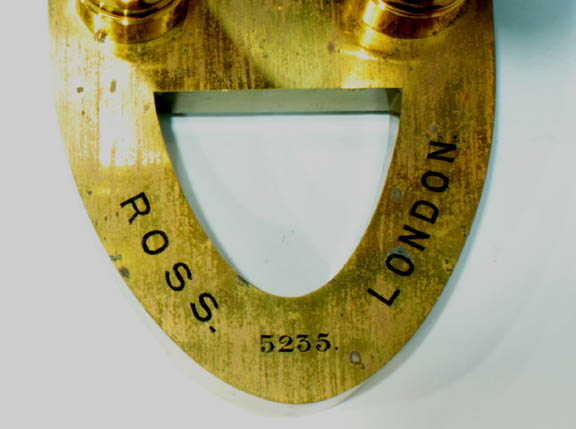
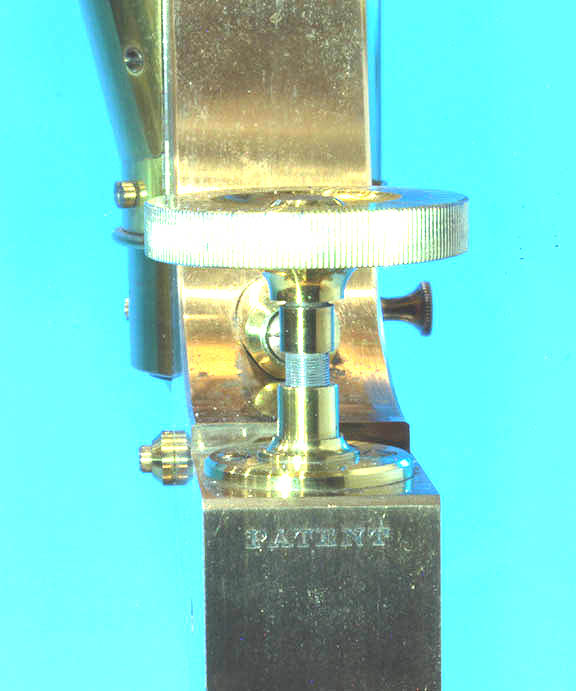
This magnificent example of a binocular Ross-Zentmayer stand arises from a lyre or 'A' shaped foot. The foot bears the words 'ROSS' and 'LONDON' surrounding the serial number of '5235'. The word PATENT
is engraved on the back of the limb near the fine focus control. Two round pillars support the trunion inclination joint. Unlike many other examples this microscope has no lever to adjust the tension on this joint which in this example requires a spanner wrench. The microscope can be inclined from vertical to to horizontal, or any position in between. There is a stop for the horizontal position. The Lister-Jackson limb supports a binocular optical tube which has interocular adjustment by rack and pinion. Coarse focusing adjustment is by diagonal rack and spiral pinion. The fine adjustment is via long lever within the limb controlled at the rear by a knurled graduated fine focus knob.
A tapering conical rod passes through the limb to support the stage and tage. Not only can the substage swing, but the stage can also be tilted and secured by the knurled knob in the rear.
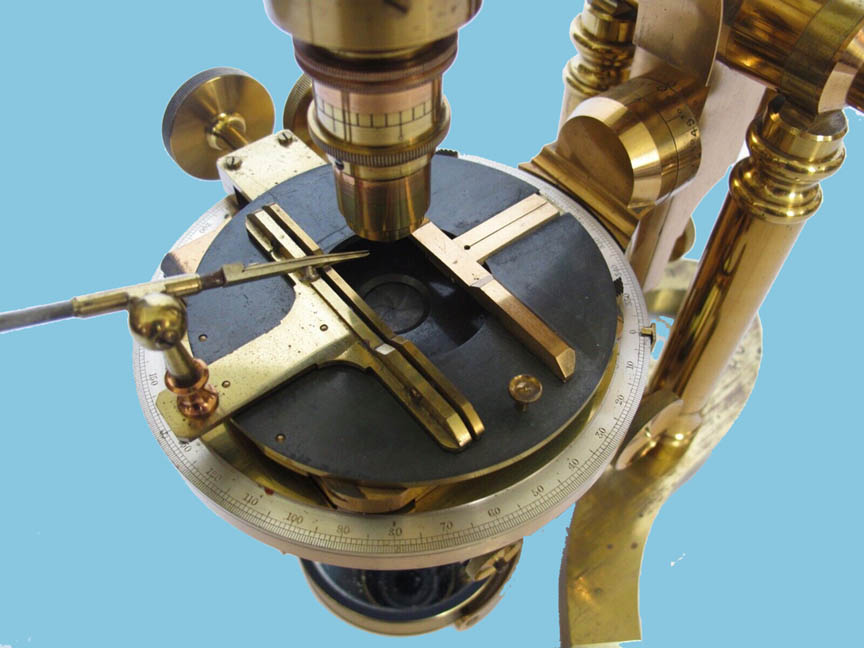
The mechanical stage has controls for X and Y movement. Movement in the X axis is via a coarse screw, Y axis is via rack and pinion. There is a 1 inch range of travel for both the X and Y directions. The mechanical stage features a blackened surface and two slide holders, one sliding in from the front and the other from the back which not only grip the slide, but allow it to be positioned as needed. The front slide holder has a receptacle for a stage forceps or other accessories. The stage is rotated by a knurled knob on the underside of the stage.
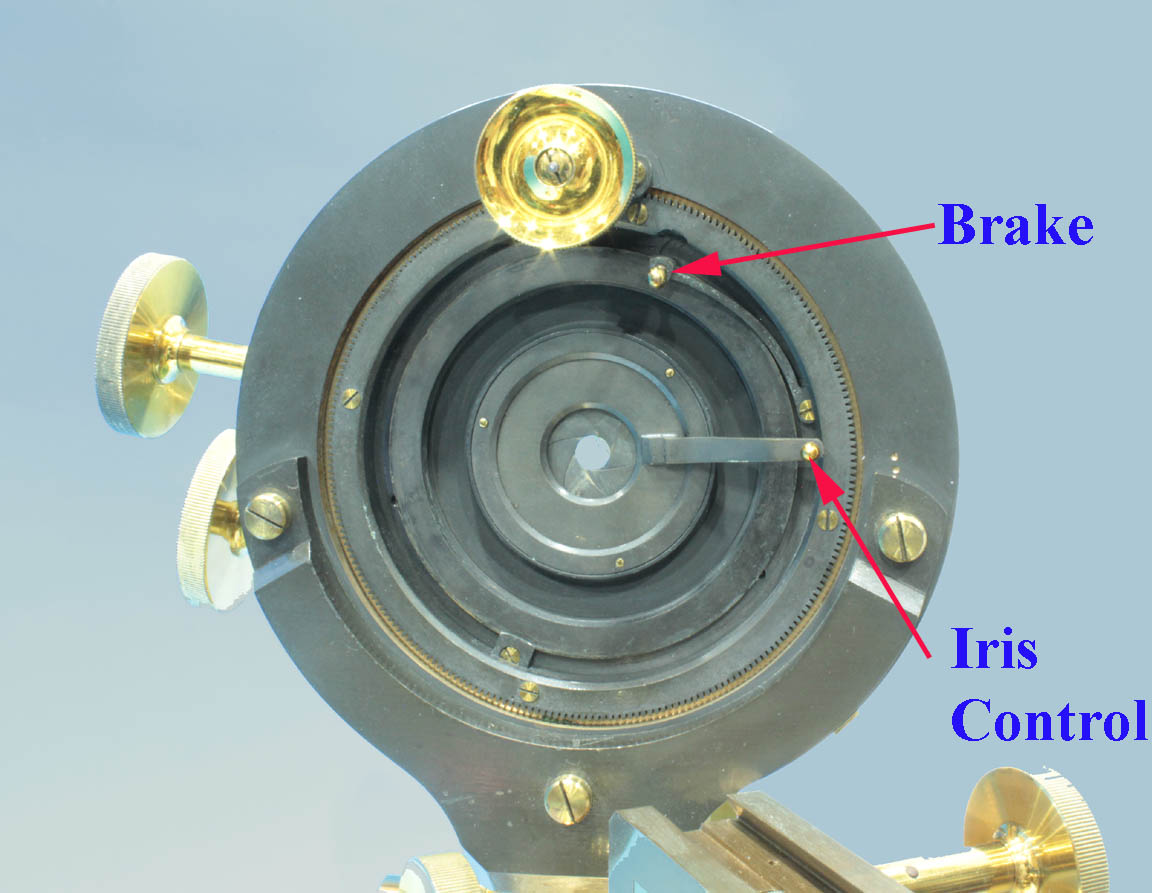
On the underside of the stage is an iris diaphragm. The iris and its control lever can be rotated into any desired postion, making it more easily accessible when the substage is tilted. Once the lever is in the desired location, the rotation of the iris, and its attached lever can be held in that position by a brake that presses on the iris housing so it does not rotate as the diameter of its opening is changed by the lever.
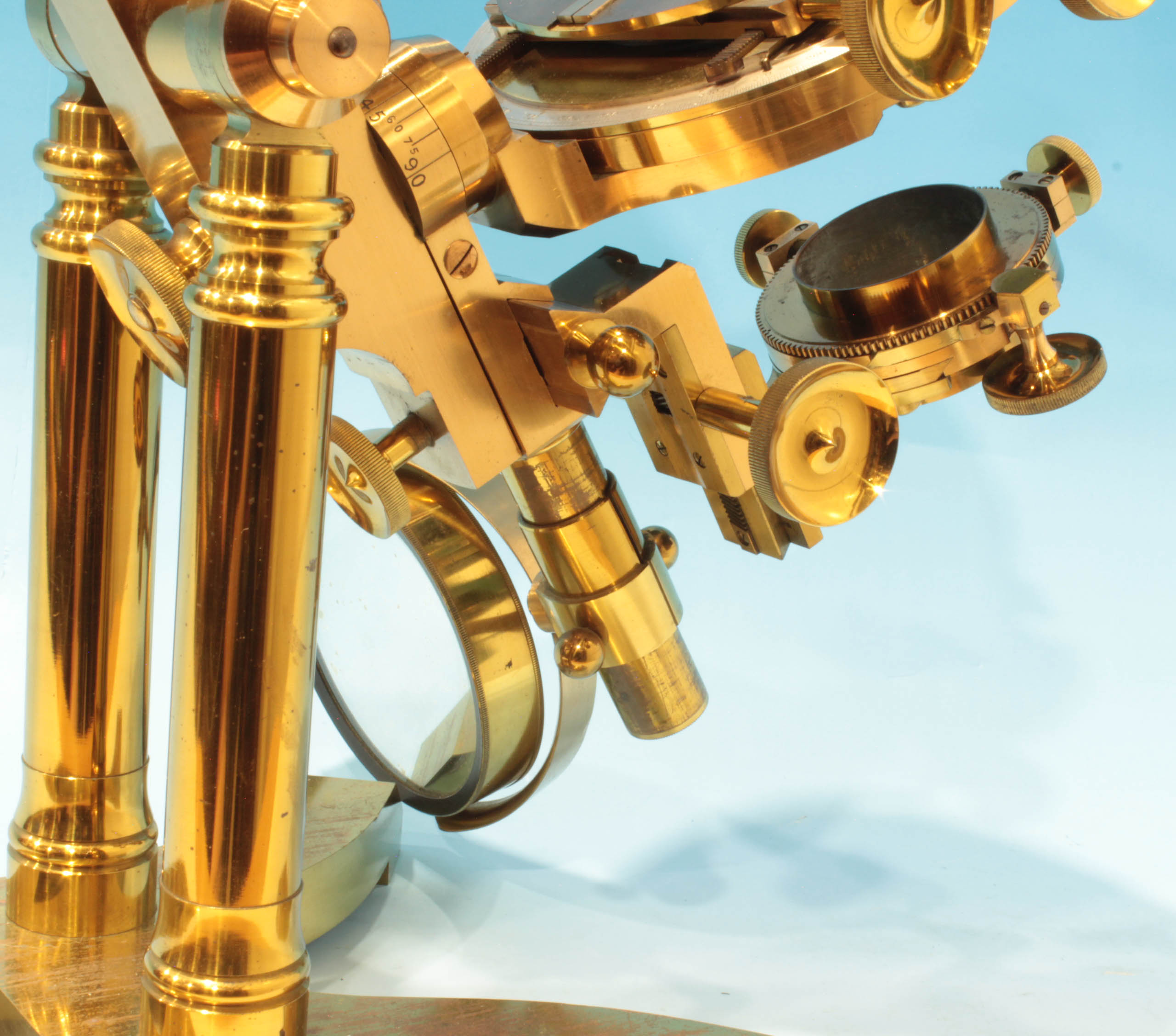
The substage assembly rides on a tailpiece that carries both the condenser assembly and the mirror. The tailpiece rotates on a ringat its top which is calibrated from zero to ninety degrees, marked and labeled in 15 degree intervals. The axis of rotation of the swinging tailpiece, (and that of the tilting stage), is around the plane of the specimen on the stage, which allows the focus of the condenser to be maintained regardless of the angle the condenser is swung to. The rack and pinion substage assembly features adjustable centering via two knurled knobs and a third knob controls geared rotation.
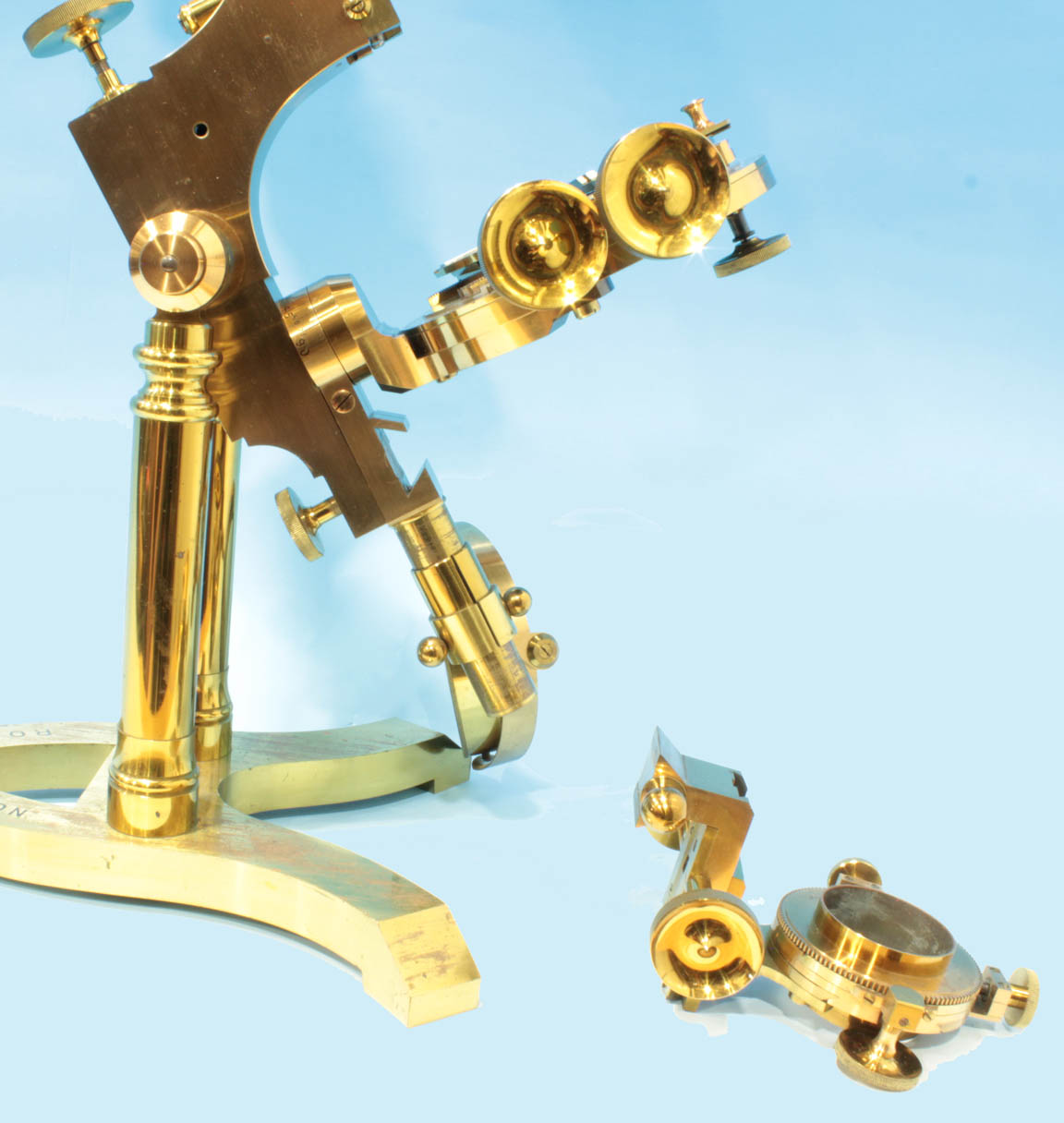
The entire condenser assembly can easily be removed from the tailpiece by pulling it out of its dovetail fitting, using the little brass handle. The gimbaled mirror has both flat and concave sides and is attached to a tube which slides up or down in the tailpiece. The tailpiece can be rigidly locked in the straight (un-swung) position by a screw with knurled knob which passes through the limb at about the level of the dovetail fitting of the condenser assembly.

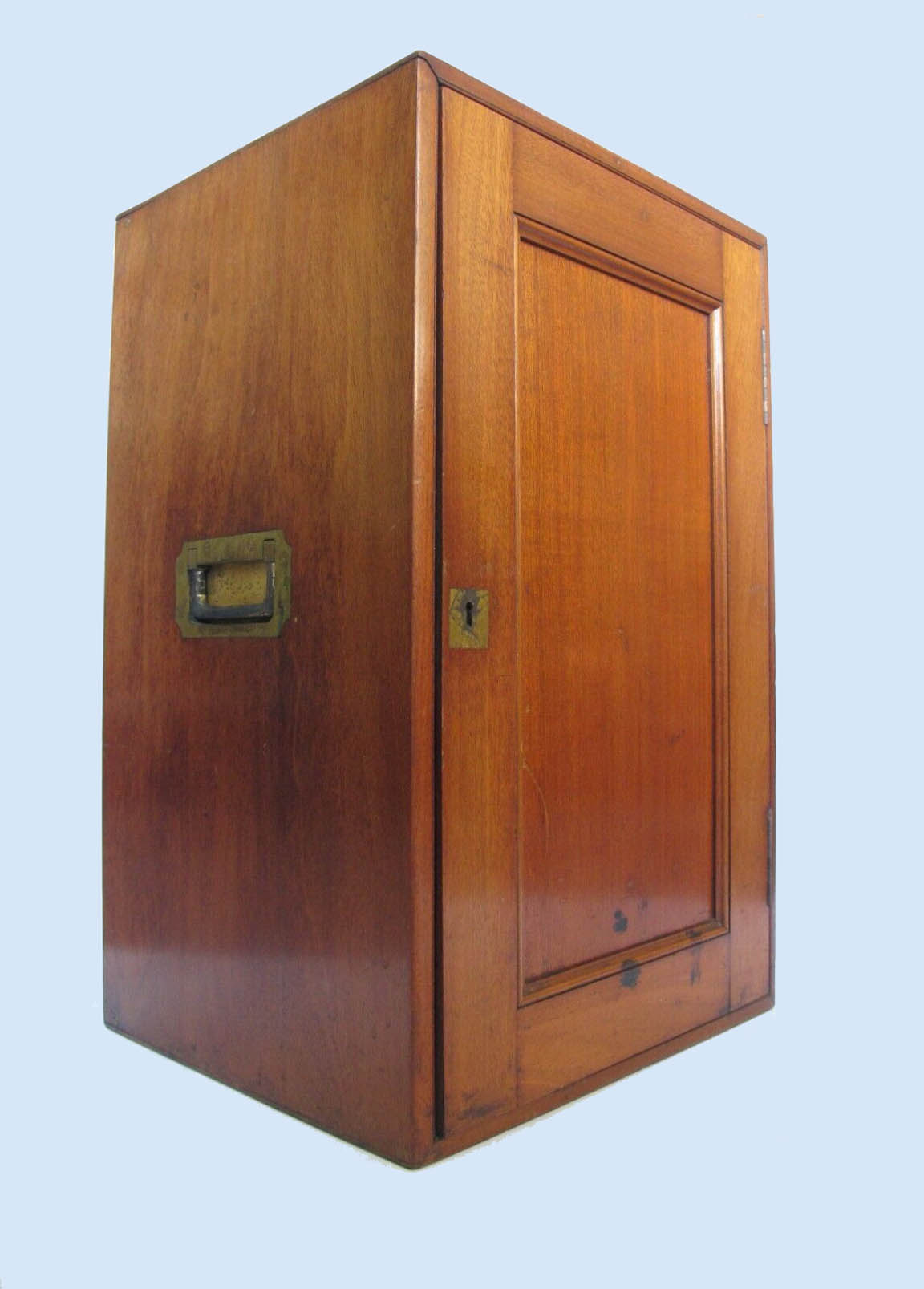
The large hardwood case houses the microscope to the right and the accessory box to the left. The box has handles installed in the right and left side.
OPTIONAL FEATURES AND ACCESSORIES ON ROSS-ZENTMAYER STANDS:
The optional features found on this stand, which include geared rotation of the condenser housing, calibration of the rotation of the stage, and geared rotation of the stage were all optional on all models of the Ross-Zentmayer microscopes according to the 1883 catalog. Calibration of the substage rotation, and calibration of the X and Y movements of the stage were other options not found on this example. The Ross-Zentmayer microscopes were available in at least four different sizes, most as monocular or binocular. These were referred to in the Ross Catalog of 1883 as the Ross Zentmayer Microscope-stand
and were also called the No. 1 (or 2 or 3 or 4)Patent Microscope
. The stand was available with a choice of three different types of foot; these included the lyre-shaped foot seen on this and the other examples in this collection, an curved English Claw
foot, as well as a folding version of the curved English Claw foot where the bottom of the two front toes fold inward, permitting it to fit in a smaller case. The number 1, (as shown on this page), is the largest, and is quite rarely seen today. The number 4 did not have rack and pinion control for the substage; in the number 4 the substage needed to be raised or lowered by pushing or pulling.
ACCESSORIES FOR THE ROSS-ZENTMAYER MICROSCOPES:
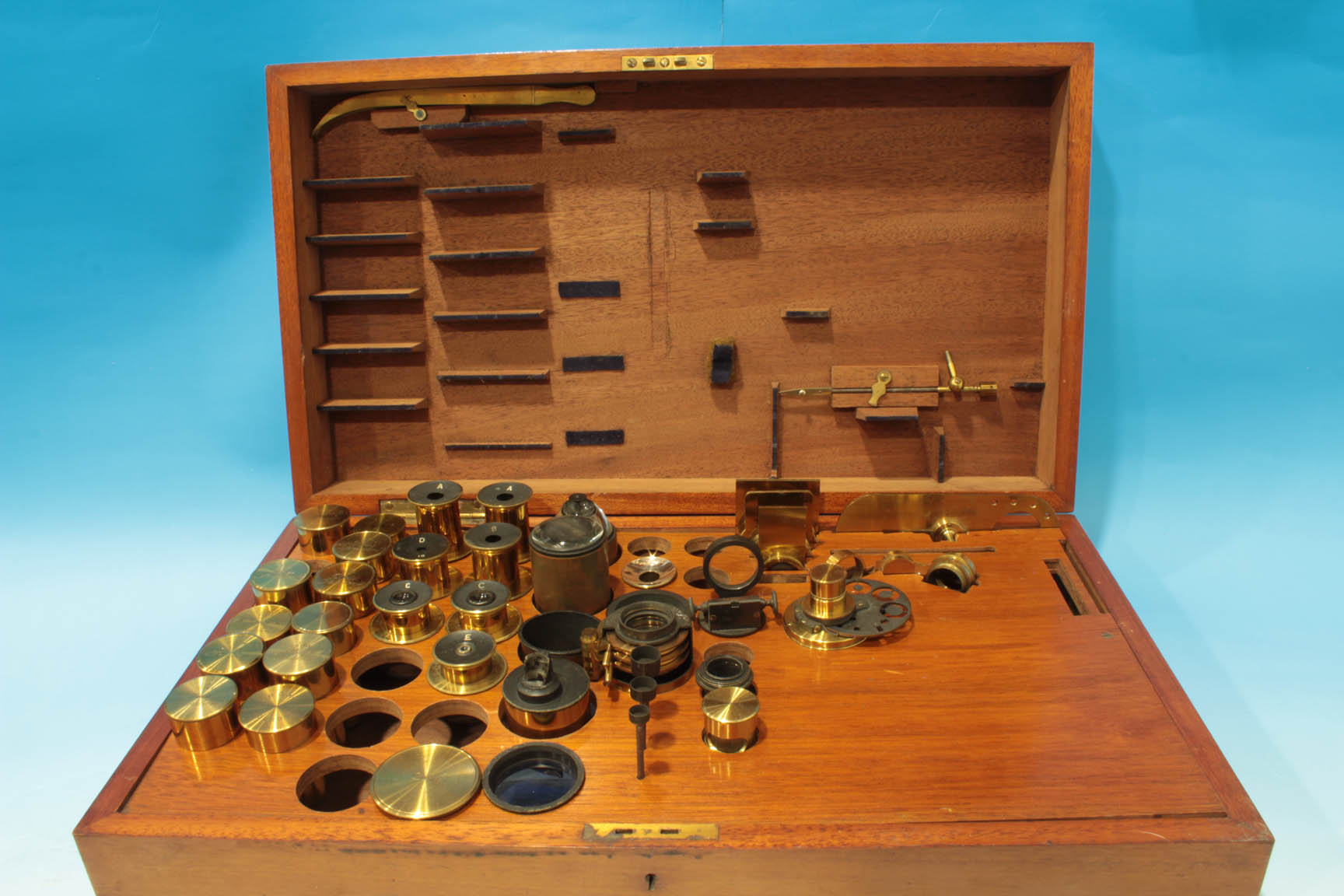
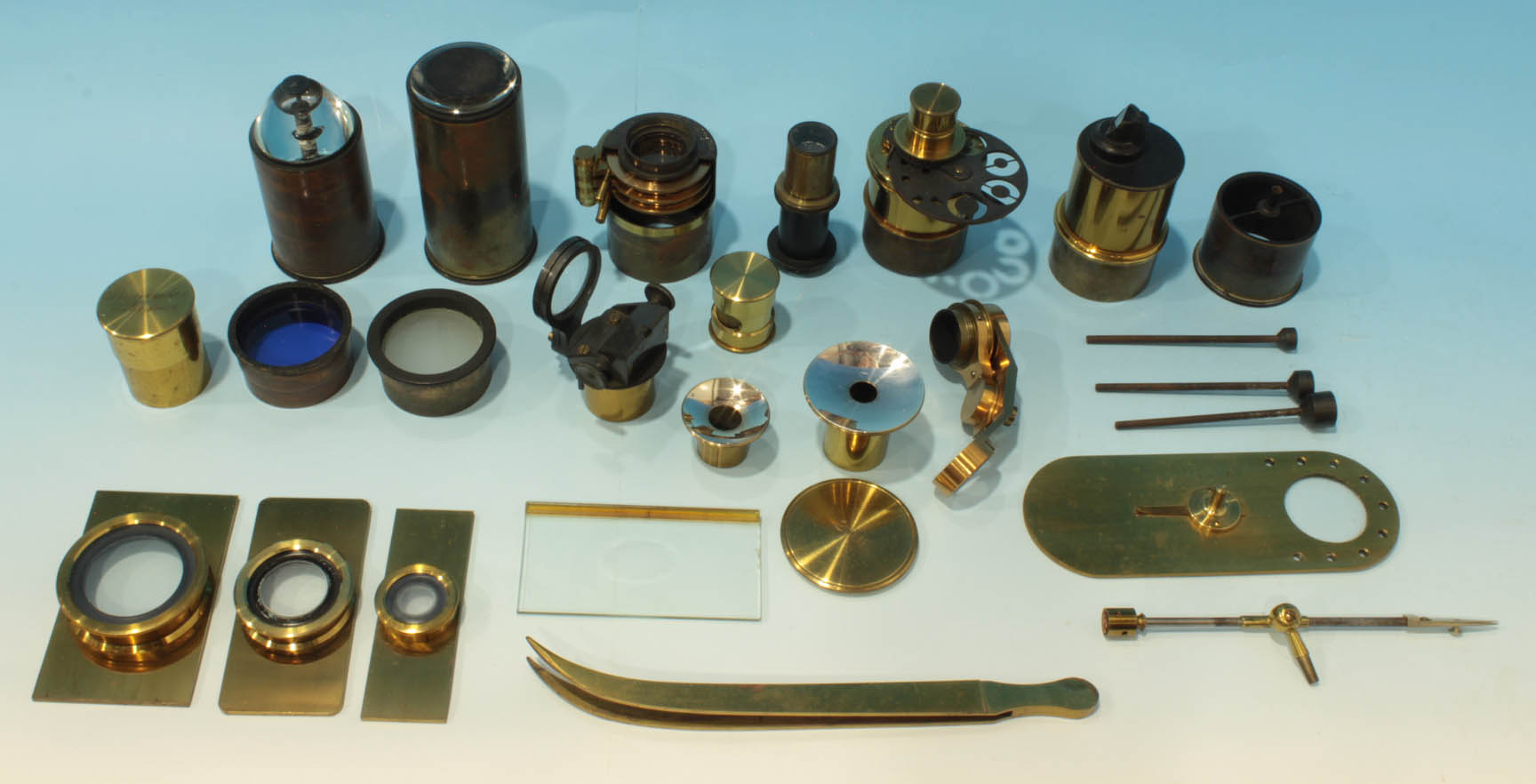 The accessories for this microscope,in addition to the 10 objectives and 7 eyepieces, include a can for the binocular prism, blue and gray light modifiers, a camera lucida, a Wenham paraboloid, a spot illuminator for dark ground work with low power, a polarizer that screws into the bottom of a stack of rotating selenites, a nosepiece analyzer, an achromatic condenser, a Wenham Reflex Illuminator, a substage fitting that holds any of three darkwells, a frog or fish plate, a stage forceps, a hand forceps, a glass ledge slide with central depression, a double objective changer for the nosepiece, and 3 different size liveboxes (see below for details).
The accessories for this microscope,in addition to the 10 objectives and 7 eyepieces, include a can for the binocular prism, blue and gray light modifiers, a camera lucida, a Wenham paraboloid, a spot illuminator for dark ground work with low power, a polarizer that screws into the bottom of a stack of rotating selenites, a nosepiece analyzer, an achromatic condenser, a Wenham Reflex Illuminator, a substage fitting that holds any of three darkwells, a frog or fish plate, a stage forceps, a hand forceps, a glass ledge slide with central depression, a double objective changer for the nosepiece, and 3 different size liveboxes (see below for details).
EYEPIECES:
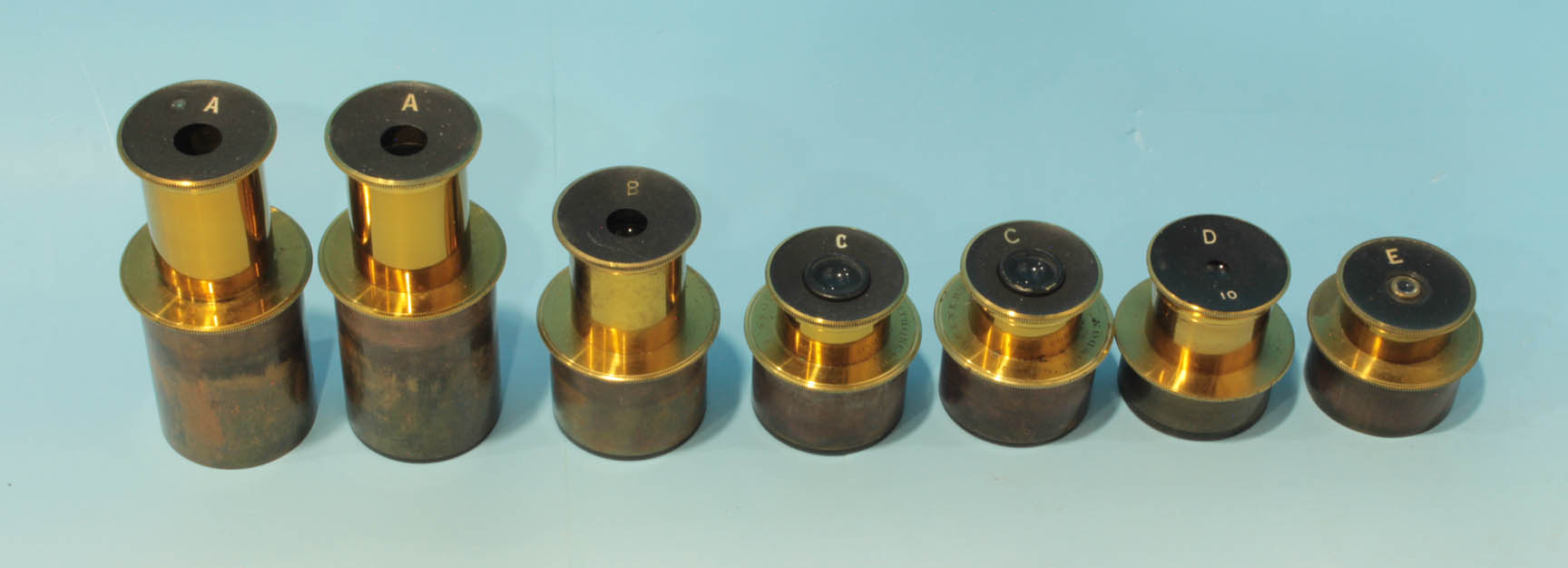
There are top hat
eyepieces including a pair of A
, a single B
, a pair of C
, a D
, and an E
. The D
eyepiece also has the number 10 inscribed on it, although according to the 1883 catalog the D has a power of 12.5X.
OBJECTIVES:

There are 10 objectives with the microscope. These include focal lengths from 4 inches to 1/12 inch. The 2 inch is unsigned in a Crouch 2 inch can, the 1/4 and 1/8 are by Powell & Lealand, and the 4 inch, 1 inch, 1/2 inch, 1/5 inch, 1/6 inch, 1/10 and 1/12 are all by Ross in Ross cans. The 1/10 has a provision for use with water immersion, with a wet
position of the correction collar labels. The 1/12 is an oil immersion objective which would be used with a high NA Abbe-type or other oil condenser. To my knowledge, Ross' only high NA condensers were the Abbe type, and only made later than this microscope as there is no Abbe or other oil condenser in the 1883 catalog. It was likely made for a later Ross microscope with the 160 mm continental tube length. Ross did not supply oil immersion condensers in the 1880s, likely because of Wenham's influence, as he was skeptical about the advantages of oil immersion and instead favored oblique illumination for increasing the visibility of small details. This may be why Ross was so late in supplying oil immersion objectives, and only after switching to continental models did they supply Abbe condensers with an N.A. of 1.20 suitable for oil immersion. Ross never advertised a dedicated higher N.A. oil immersion condenser, likely leaving owners of Ross stands to fit them with oil immersion condensers by other makers.
CONDENSERS & SUBSTAGE FITTINGS:
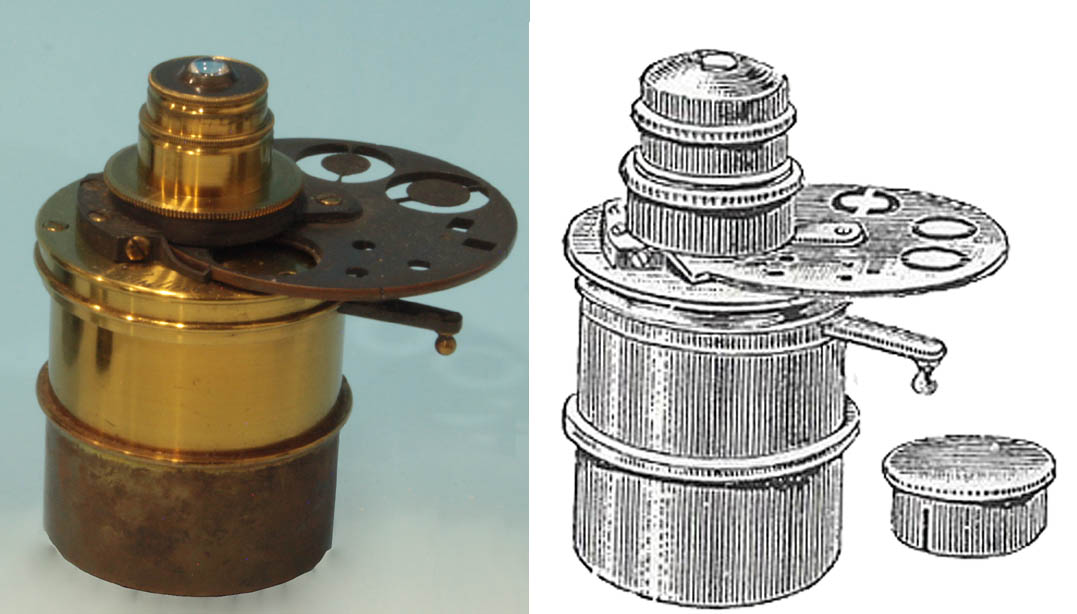
ROSS' IMPROVED IRIS CONDENSER
:
This achromatic condenser, with removable top elements provides a wide cone of light and suitable for most powers. The top element can be removed for use with low power objectives. A lens cap with a central hole allows for accurate centering of the condenser in the optical path.
 POLARIZED LIGHT ACCESSORIES: Among the accessories is a special fitting with 3 swing-out selenites, each of which could be used singly or combined and is individually rotatable. In this example of this accessory, the polarizer screws in to the bottom of the housing that contains the selenites and this housing can accept a lens on top for higher power work. A nosepiece analyzer attaches to the nosepiece above the objective and can be rotated at will. In another example on this site, the polarizer is integrated into the bottom of the selenite housing.
POLARIZED LIGHT ACCESSORIES: Among the accessories is a special fitting with 3 swing-out selenites, each of which could be used singly or combined and is individually rotatable. In this example of this accessory, the polarizer screws in to the bottom of the housing that contains the selenites and this housing can accept a lens on top for higher power work. A nosepiece analyzer attaches to the nosepiece above the objective and can be rotated at will. In another example on this site, the polarizer is integrated into the bottom of the selenite housing.
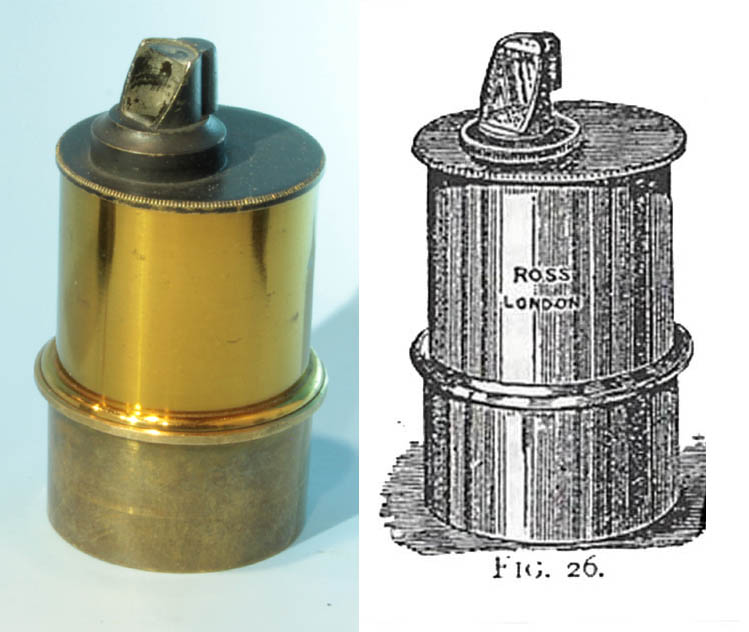
WENHAMS REFLEX ILLUMINATOR
was shown in the Ross 1883 catalog and noted in the JRMS in 1883. It provides dark ground illumination for higher powers. It requires immersion to the bottom of the slide, and accurate centering of the indicating dot on top of the support for the optics. The higher the refractive index of the immersion solution, the higher power and n.a. objective that can be used with it.
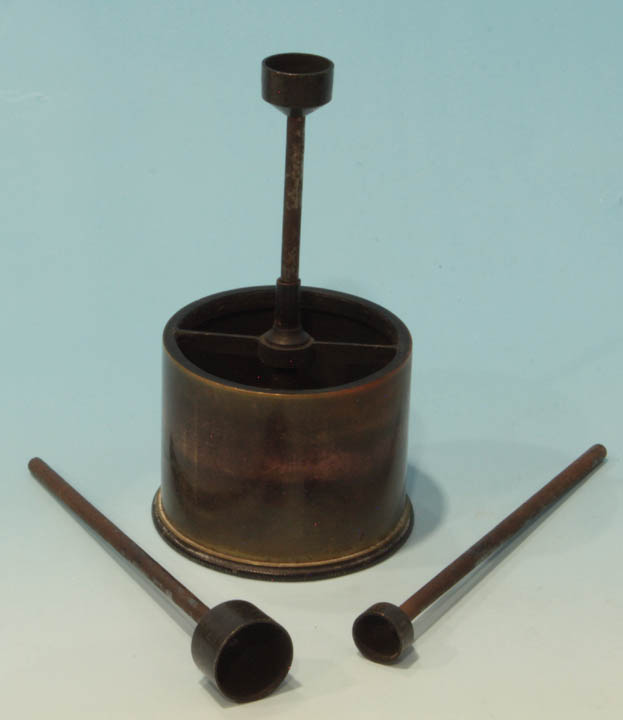
A DARK WELL HOLDER, sliding into the substage from below, provides a choice of three dark wells for viewing opaque objects in a dark cup. The objective would have a Lieberkuhn relector attached to it to reflect light down on the subject inside the little cup.
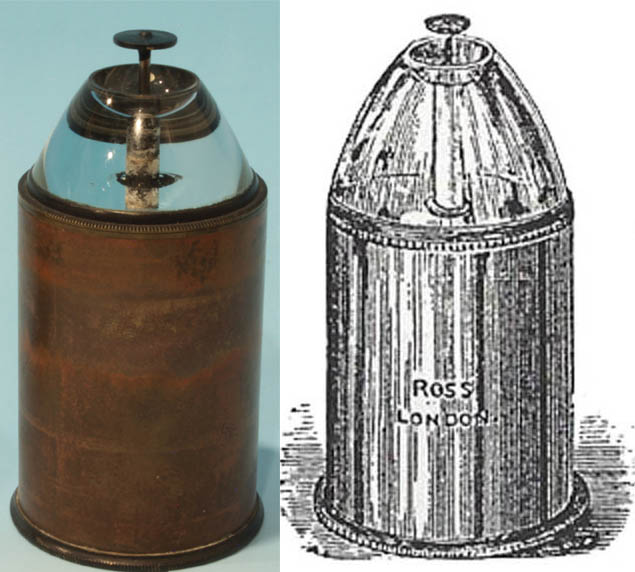
According to the 1875 catalog, WENHAM'S PARABOLOID
with a central stop, could provide dark ground illumination for objectives with focal lengths as short as 1/5th inch. The distance of the stop from the top of this accessory can be varied to suit the focal length of the objective.
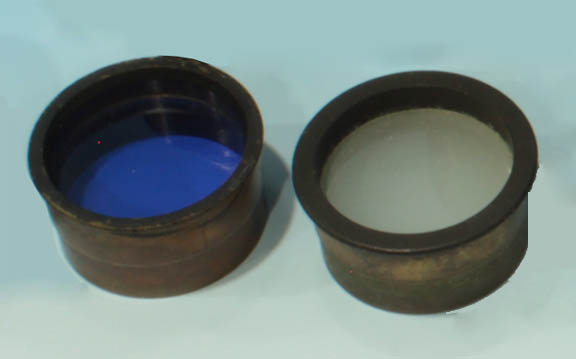
Two LIGHT MODIFIERS
were supplied, one a blue filter, the other a grey
. The latter is actually a frosted glass diffuser. These could be used alone or with the Wenham's Diffusion Condenser
(not present). The diffusion condenser had three plano-convex lenses of deep curvature superimposed and decreasing in size which condense a cone of 170o on to a layer of fine glass borings between thin glasses, which scatters the light, whose tone is modified by a blue or grey glas fitting
. This arrangement was designed primarily for viewing objects with transmitted light when viewed with a Wenham-binocular microscope.
When the light modifiers are used with a condenser, the condenser slides into the substage ring from the top while the light modifiers slide in from below. When used alone they can be inserted either from the top or bottom of the ring.
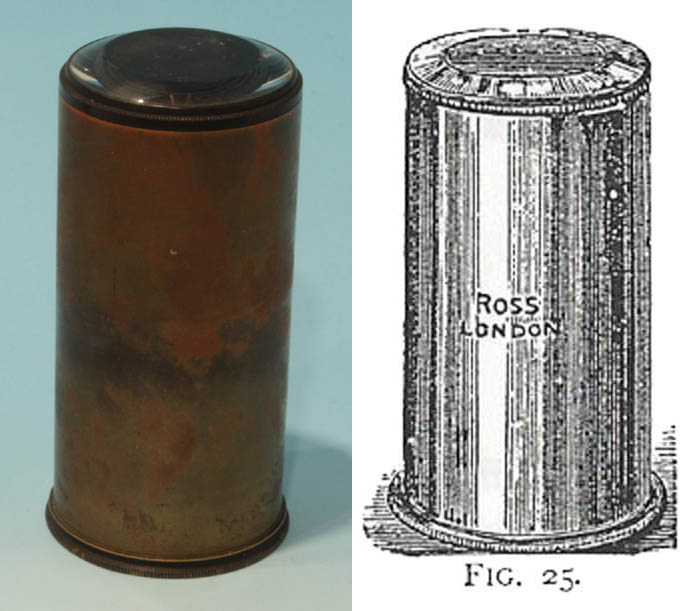
The SPOT LENS
is a dark ground condenser which utilizes a large planoconvex lens with a central stop for providing dark ground illumination with low power objectives or large objects. It was provided in two sizes.
OTHER ACCESSORIES:
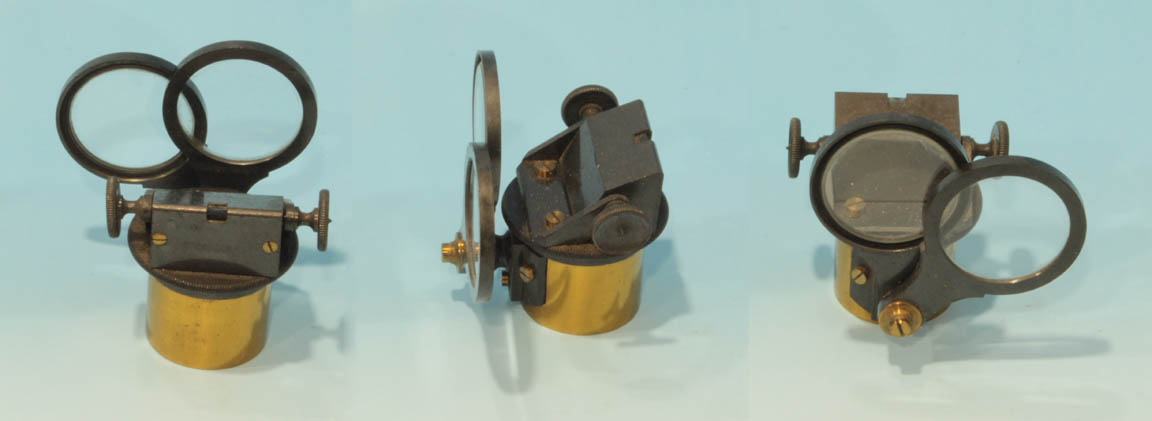
The Wollaston-type of Camera Lucida supplied by Ross replaces the cap on the top-hat eyepieces. It is used as a drawing aid whereby the image in the microscope appears superimposed on the drawing surface.
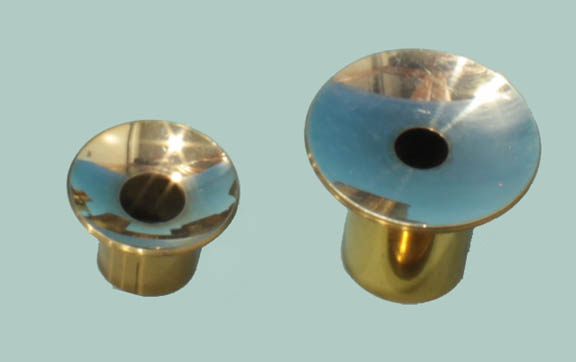 TwoLieberkuhns are present, the larger one for the a low power objective and the other for an obective of medium power. They fit on the end of the objectives they are designed for, reflecting light down on to opaque objects.
TwoLieberkuhns are present, the larger one for the a low power objective and the other for an obective of medium power. They fit on the end of the objectives they are designed for, reflecting light down on to opaque objects.
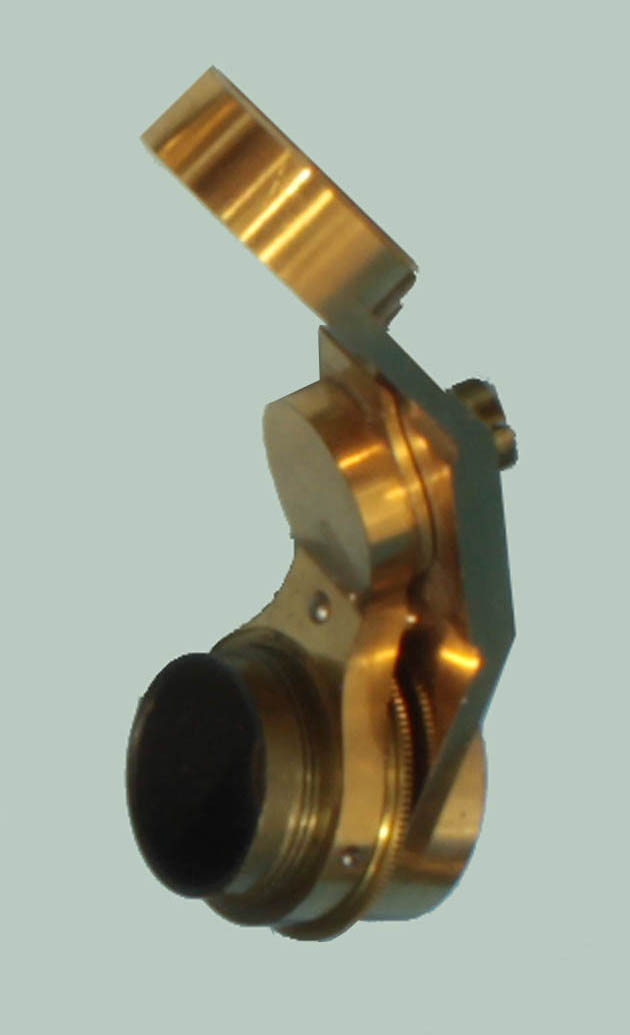
The Brooke's Double Nosepiece
allows rapid switching between two objectives.
 The stage-forceps was a commonly supplied accessory with many microscopes, both in the 18th and 19th centuries and was still offered in the 20th century. It was suitable for holding a leaf or an insect etc. It has a fitting with a cork on the other end to which an object could be pinned. It would not be suitable for holding a hard object like a mineral for which
The stage-forceps was a commonly supplied accessory with many microscopes, both in the 18th and 19th centuries and was still offered in the 20th century. It was suitable for holding a leaf or an insect etc. It has a fitting with a cork on the other end to which an object could be pinned. It would not be suitable for holding a hard object like a mineral for which Vice-Forceps
or a 3-pronged tenaculum or Mineral Forceps
would be better suited. More complex apparatus for detailed examination of minerals and determining their optical properties such as stage goniometers and integrating stages became available later in the 19th century.

Another common accessory, the hand forceps, simply made picking up small objects easier.
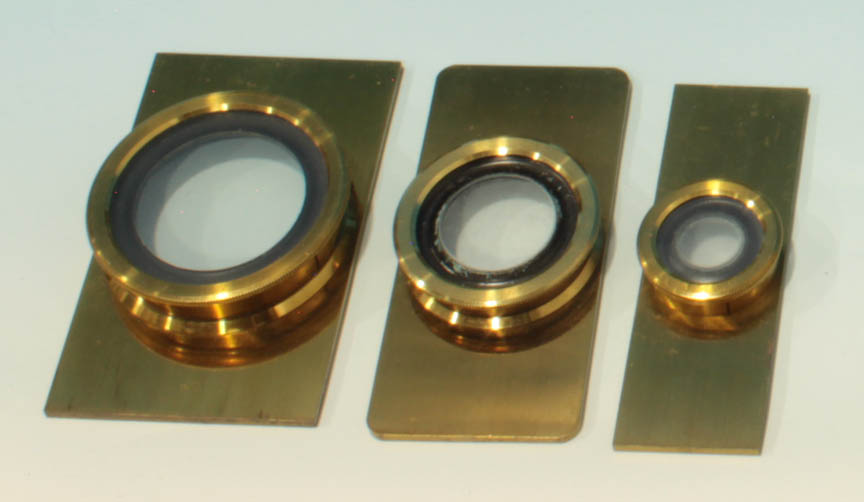
Ross supplied three or more sizes of liveboxes which the 1883 catalog still called animalcules cages
. These are an improvement on the original type, and are similar to the ones invented by Varley with a channel for extra fluid, and the top press-fitting over the bottom. They serve to trap small organisms in a liquid medium for observation. These can also serve as crude compressors.
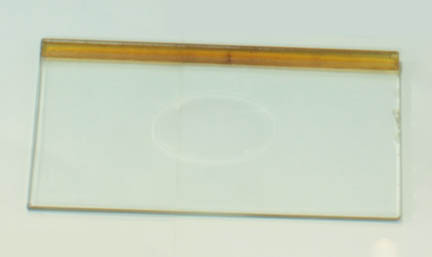
This is a Glass slip with ledge and depression
which was used to quickly observe a liquid specimen covered with a cover slip. This slip
would today be called a slide.
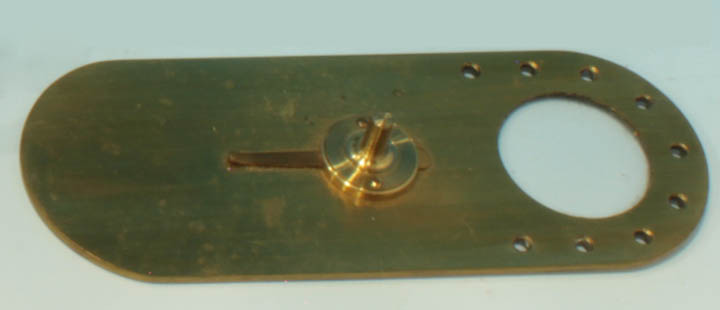
This accessory was designed to allow one to view the circulation of the blood in the capillaries of a fish tail or frog foot web. It is fixed to the stage with the peg shown which fits into a hole one of the slide holders. The subject is wrapped in wet cloth and tied in place with a cord wrapping around the subject and going through the holes with the end of the cord secured by the tab next to the peg.
CONDITION:
Overall this large microscope is in excellent condition. There are some areas of the foot where the lacquer is slightly blemished and some tiny areas of lacquer loss on the foot and the tube. All controls work perfectly. The mirror has some tiny losses on the flat side and some more losses on the curved side. There are some tiny losses on the mechanical stage. The silvering of the stage rotation is excellent. The accessories are all in very good working condition. The case is in very good condition with minor scuffs to the finish also noted on the accessory case. The top of the accessory case is warped and therefore does not close well. All the accessories are in very good overall condition.
HISTORY OF ROSS-ZENTMAYER MICROSCOPES
The firm of Andrew Ross dates back to the 1830's or earlier. The first known reference to him appeared in the Transactions of the Society of Arts in 1832, p 413 where it mentions his construction of a microscope for Valentine in 1831. In the achromatic era dating from about 1839, Ross soon became the foremost maker of microscopes in England. His instruments were of high quality, and although sometimes not up to the extreme standards of the small company of Powell and Lealand, his stands were more popular, less expensive and made in much greater numbers. When Andrew died in 1859, his son Thomas took over the business. When Thomas died in 1870, Francis Wenham was called upon to direct the further production of microscopes. In 1882 he designed the complexRadial
microscope that often bears his name. Wenham left the firm that same year.
Wenham, primarily a marine engine and propeller engineer, also contributed greatly to early aviation theory and some of his work likely influenced the Wright Brothers. Among Wenham's accomplishments were his high pressure steam engines which were able to increase the speed of ships faster then the earlier low pressure steam models. Wenham's constributions to microscopy were also quite extensive, so much so, that, as noted above, he was chosen to help guide the designs of the Ross company once Thomas Ross had died.
One of the major pursuits of microscopists of the last quarter of the nineteenth century (and before), was a desire to increase contrast and resolution. Before Abbe's theories were popularized, one of the ways this was accomplished was via the use of oblique illumination via an angled light source below the stage. From this, it followed that the greater range of choices of oblique illumination, and the more extreme it could be, the more likely that a suitable arrangement could be achieved for optimal resolution and contrast of fine features of microscopical objects, especially diatoms. With the small diameter condensers of the time, extreme degrees of oblique illumination could only be achieved by illuminating from an angle rather than directly from below with the light parallel to the optical axis and perpendicular to the stage. Swinging substages that did not swing in the axis of the slide existed long before, and one that rotated in the axis of the specimen was originally introduced years before, for example in the early 1850s, exemplified by the Grubb Sector Microscope, but the idea did not then take off. The first person to popularize a method in which the swinging substage for this purpose rotated through the axis of the specimen and therefore did not have to be refocused as it swings, was the famous American microscope maker, Joseph Zentmayer. By having its axis of rotation at the plane of the slide, the focus of the condenser was maintained throughout the range of obliquity. This feature soon became very popular and Francis Wenham quickly became one of its proponents in England. Additional important characteristics of this arrangement are the fact that the condenser had to be narrow enough to allow this without getting blocked by the edge of the stage, and also that the stage was thin enough so as not to obstruct illumination from an extremely oblique angle. These became the essential features of the Ross-Zentmayer microscopes.
The English patents for these microscopes were applied for in 1876 and 1877. These models were first exhibited to the RMS in 1878(see JRMS 1878 p 163 and 197-199) but there was no illustration of them in the JRMS that year. The first illustration of the Ross-Zentmayer model that we are aware of appeared in the January 1880 Ross Catalog, showing the microscope on an English curved claw
foot, with concentric mechanical stage controls (left). The model was referred to there as the New Patent Microscope
. It was stated from the first that there were 4 different versions, Nos 1 to 4, and that the curved claw foot could be ordered solid or with folding feet to fit in a more condensed case (with all its accessories). The folding curved English claw foot
example shown below has a serial number of 5029 which dates it to about 1880:
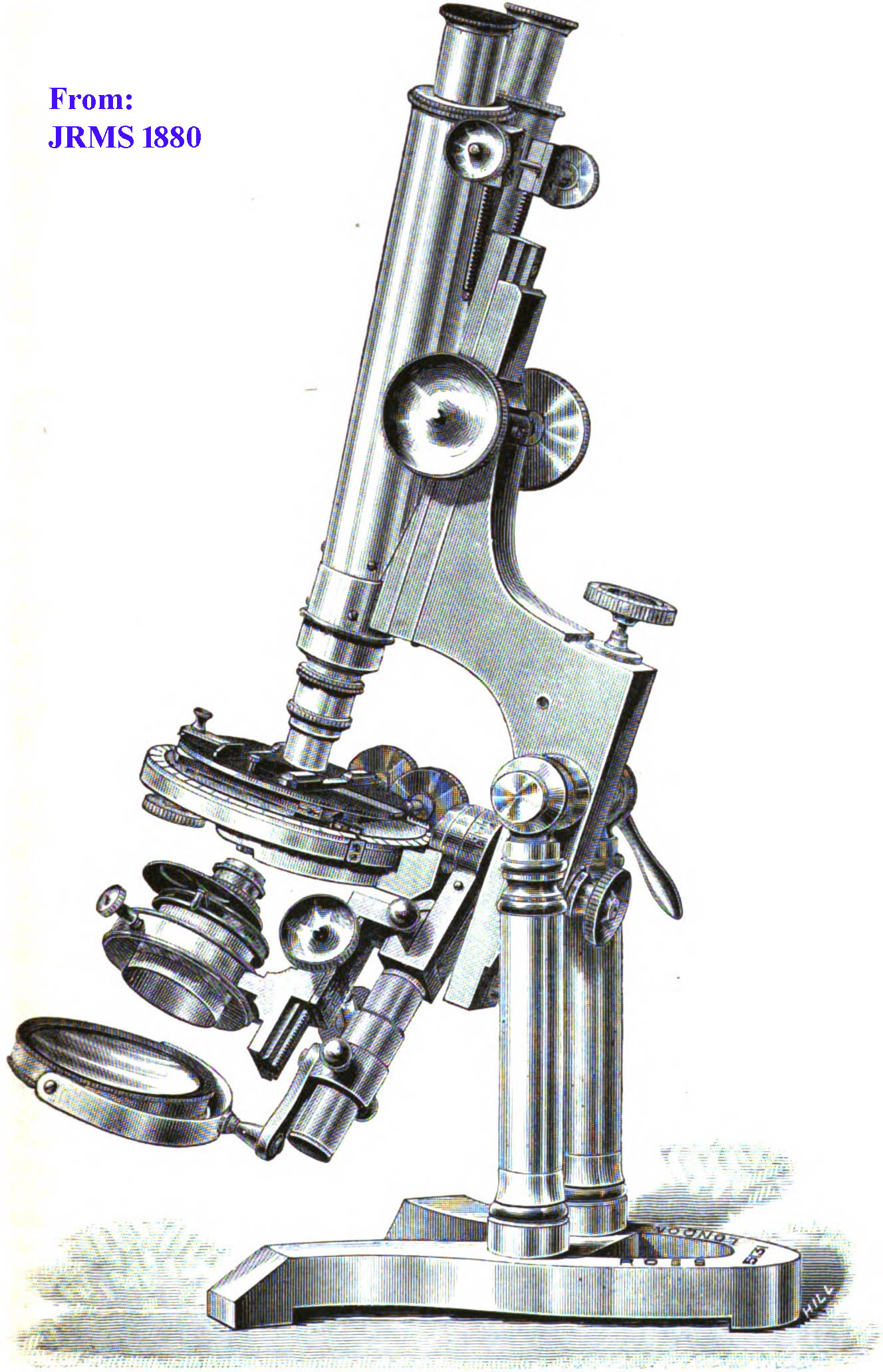
The Ross Zentmayer was first shown in the JRMS later in the same year(1880) on page 704, but this time with the lyre-shaped foot. By the time the 1882 catalog came out, the claw foot (folding or not folding), and the lyre-shaped foot were both offered. As shown below, the Ross-Zentmayer models also appeared in the 1882 and January of 1883 catalogs. As noted above there were four models. Number 1 was the largest, number 2 slightly smaller, and number 3 smaller yet. The smallest and least complex was the number 4. All the Ross-Zentmayer stands could be ordered with any one of the three different variants of the foot.
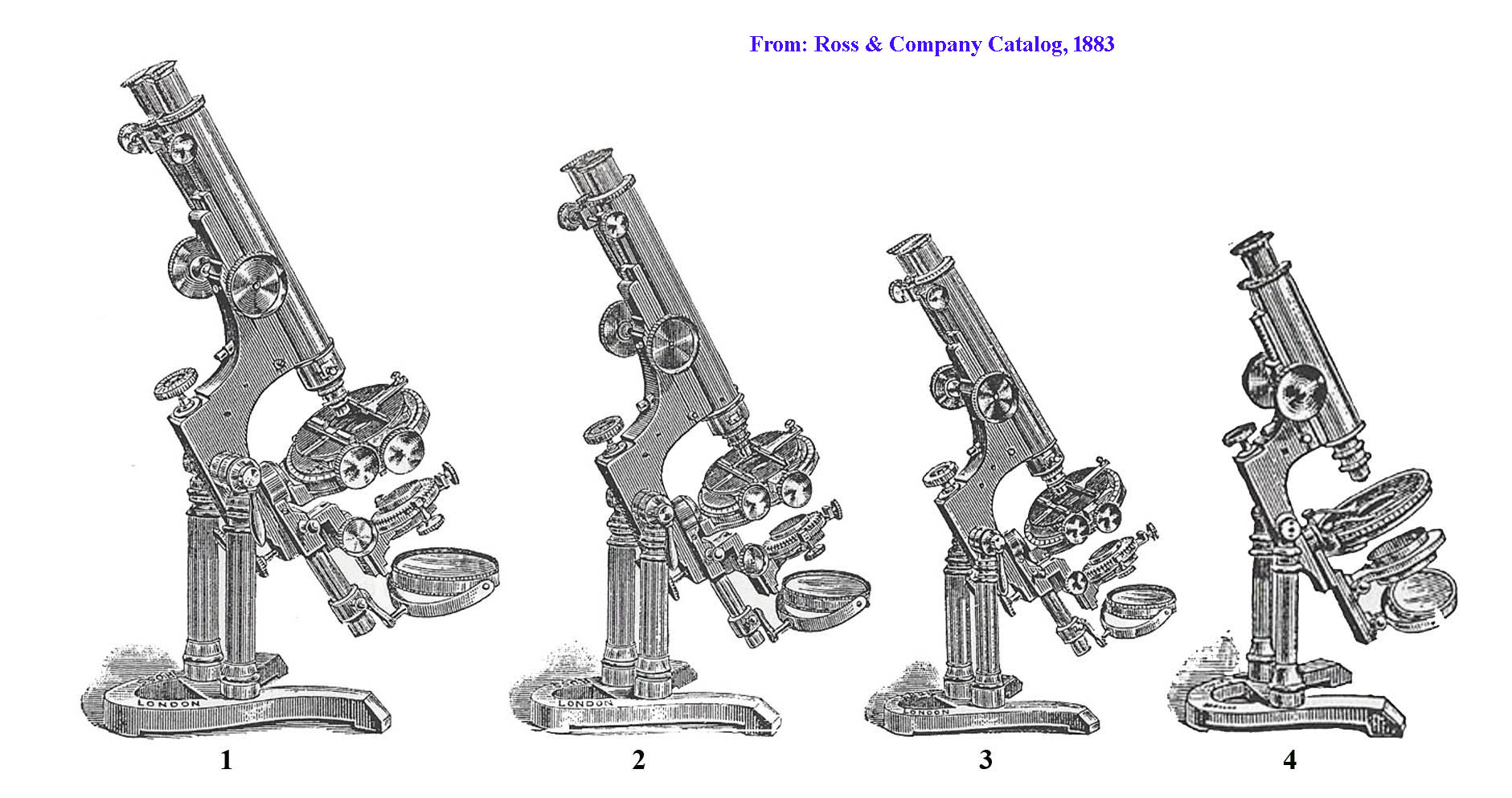
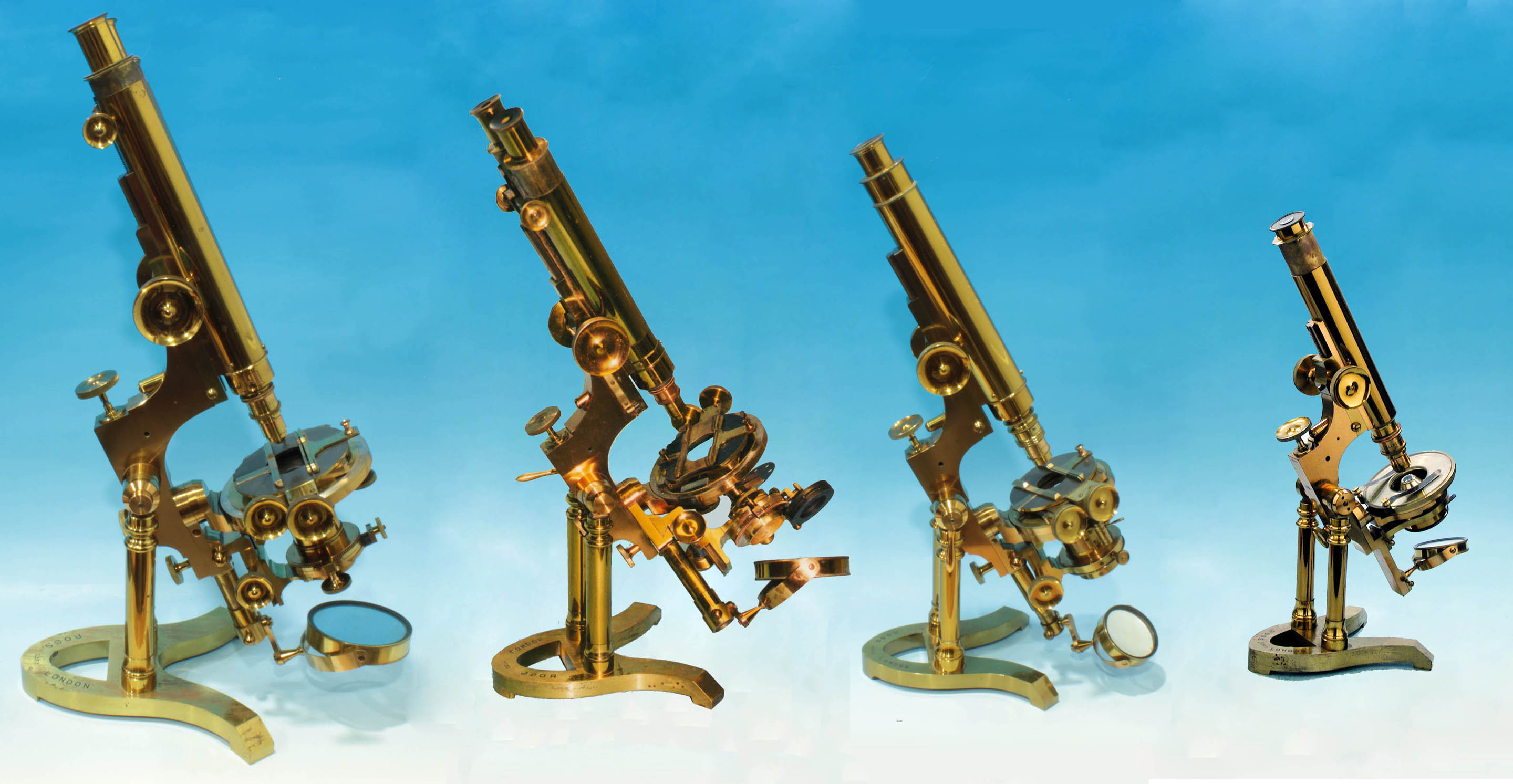
| MODEL |
CALIBRATED
STAGE
ROTATION |
RACK &
PINION
STAGE
ROTATION |
RANGE OF
MOTIONS OF
MECHANICAL
STAGE
| GEARED
SUBSTAGE
ROTATION |
SUBSTAGE
CENTERING |
CALIBRATIONS
FOR X & Y STAGE
MOVEMENTS | MAXIMUM OUTER
DIMENSIONS of
LYRE-SHAPED FOOT
(A X B) |
| NO. 1 |
Standard |
Optional* |
1" |
Optional* |
Standard |
Optional |
20.3 X 22.5 cm |
| NO. 2 |
Optional* |
Optional* |
3/4" |
Standard |
Optional* |
Optional |
|
| NO. 3 |
Optional* |
Optional* |
1/2" |
Standard |
Optional* |
Optional |
15 X 17.5 cm |
| NO. 4 |
No |
No |
(NA) |
No |
No |
(NA) |
|
*These features were optionally deleted for a discount in price.
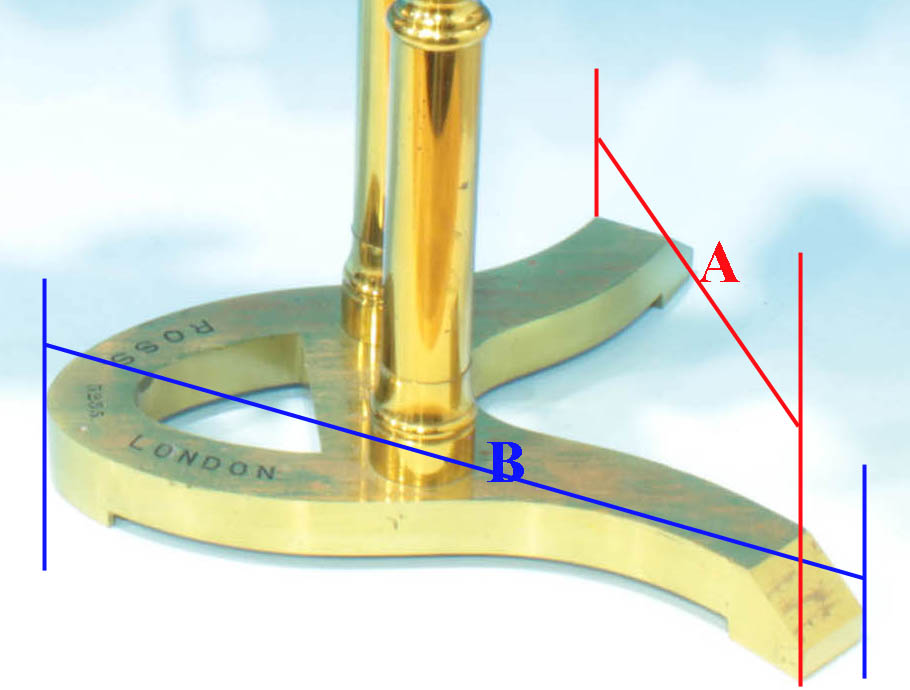
The construction of these instruments differed slightly. The number 1 had a graduated stage rotation standard, and although the numbers 2,3 and 4 had rotatable stages, the graduations were optional on these models. Although the No 1, 2, and 3 had geared rotation for the stage standard, and optionally deleted, the number 4 rotated by hand only. Each of the models with a mechanical stage had different ranges of motion for the X and Y axes of the mechanical stages. The No 4, unlike the other three, did not have a mechanical stage and its substage also differed in that it was focused by sliding rather than rack and pinion as the other three. Centering and rotation of the substage mount, standard on the other three, was not a feature of the number 4. It should be noted that for a discount, the number 1, number 2 and number 3 stands could also be ordered without substage rotation. An example of the No 1 without geared rotation to the stage or substage is the example with folding feet shown above.
According to an advertisement in the JRMS of 1898 and the Annual Review of Microscopy of the same year, Ross had introduced continental stands by that year, but, as noted above, continued to offer the Ross-Zentmayer and Wenham Radial microscopes at that time. By the early 20th century, with widespread knowledge of Abbe's work, Ross adopted the continental form of microscope and the Ross Zentmayer model was abandoned.
Not only did Wenham come up with the Ross-Zentmayer models, but an even more complex stand which became known as the 'Wenham Radial' or the 'Ross Radial' a rare microscope which was already obsolete when first produced. Wenham applied for the patent of the Radial
in 1881 and it was first produced in 1882. The inclusion of the swinging substage on microscopes soon faded as the newly introduced Abbe condensers with their much larger lenses appeared. The addition of a swing-out ring which could hold filters or metal inserts with various openings and a moveable iris diaphragm, or both, allowed oblique lighting to be easily achieved in these large lens condensers, without the swinging substage. Either asymmetrical stops could be inserted in the swing-out ring, or in some examples, the iris could be offset to the edge of the optical path of the condenser so as to direct the light obliquely.
Furthermore, the Ross-Zentmeyer design had major flaws in the design of their fine focus mechanisms(as did Zentmeyer's own), which also limited the popularity of the Ross-Zentmeyer stands. The design was flawed in three ways. First, the long lever focus employed a flimsy lever which was not rigid enough, leading to backlash. Secondly this flimsy lever was not rigid enough to regularly overcome the friction of the dovetail for the fine focus mechanism. Lastly, as the brass in the dovetail wore with use, there was no way to adjust the friction, so the tube could wobble to the right or left. Multiple attempts to improve the situation included the use of rollers, and/or washers, but these were met with very limited success. Others, most notably Watson*, had success with the long-lever fine focus. It is of some interest that with the exception of the small Student Tripod Microscope
the only microscopes offered in the 1883 Ross catalog were the Radial and the various iterations of the Ross-Zentmayer. By 1895 the Ross company was still offering the Ross-Zentmayer model but had also started to supply stands with continental limbs as noted in the Transactions of the American Microscopical Society of that year. By 1900, the age of the swinging substage had come to an end.
In 1882, the first year of production of the 'Wenham Radial,' Francis Wenham became disenchanted with microscopy, having been embarassed by his erroneous and widely publicized disagreements with Robert Tolles. After 1882 Wenham no longer directed microscope development at Ross. The Ross-Zentmayer stands quickly gave way to more modern continental stands, but by 1906 Ross was no longer making microscopes at all.
*Watson found ways to deal with these fine focus issues by making the dovetails adjustable for wear and using a much beefier lever. Their fine focus mechanism was successful for many decades, most famously on their Van Heurck Models, which were also updated with substages that did not swing, but accomodated the much larger condensers of the time.









 The accessories for this microscope,in addition to the 10 objectives and 7 eyepieces, include a can for the binocular prism, blue and gray light modifiers, a camera lucida, a Wenham paraboloid, a spot illuminator for dark ground work with low power, a polarizer that screws into the bottom of a stack of rotating selenites, a nosepiece analyzer, an achromatic condenser, a Wenham Reflex Illuminator, a substage fitting that holds any of three darkwells, a frog or fish plate, a stage forceps, a hand forceps, a glass ledge slide with central depression, a double objective changer for the nosepiece, and 3 different size liveboxes (see below for details).
The accessories for this microscope,in addition to the 10 objectives and 7 eyepieces, include a can for the binocular prism, blue and gray light modifiers, a camera lucida, a Wenham paraboloid, a spot illuminator for dark ground work with low power, a polarizer that screws into the bottom of a stack of rotating selenites, a nosepiece analyzer, an achromatic condenser, a Wenham Reflex Illuminator, a substage fitting that holds any of three darkwells, a frog or fish plate, a stage forceps, a hand forceps, a glass ledge slide with central depression, a double objective changer for the nosepiece, and 3 different size liveboxes (see below for details).



 POLARIZED LIGHT ACCESSORIES: Among the accessories is a special fitting with 3 swing-out selenites, each of which could be used singly or combined and is individually rotatable. In this example of this accessory, the polarizer screws in to the bottom of the housing that contains the selenites and this housing can accept a lens on top for higher power work. A nosepiece analyzer attaches to the nosepiece above the objective and can be rotated at will. In another example on this site, the polarizer is integrated into the bottom of the selenite housing.
POLARIZED LIGHT ACCESSORIES: Among the accessories is a special fitting with 3 swing-out selenites, each of which could be used singly or combined and is individually rotatable. In this example of this accessory, the polarizer screws in to the bottom of the housing that contains the selenites and this housing can accept a lens on top for higher power work. A nosepiece analyzer attaches to the nosepiece above the objective and can be rotated at will. In another example on this site, the polarizer is integrated into the bottom of the selenite housing.






 TwoLieberkuhns are present, the larger one for the a low power objective and the other for an obective of medium power. They fit on the end of the objectives they are designed for, reflecting light down on to opaque objects.
TwoLieberkuhns are present, the larger one for the a low power objective and the other for an obective of medium power. They fit on the end of the objectives they are designed for, reflecting light down on to opaque objects. 
 The stage-forceps was a commonly supplied accessory with many microscopes, both in the 18th and 19th centuries and was still offered in the 20th century. It was suitable for holding a leaf or an insect etc. It has a fitting with a cork on the other end to which an object could be pinned. It would not be suitable for holding a hard object like a mineral for which
The stage-forceps was a commonly supplied accessory with many microscopes, both in the 18th and 19th centuries and was still offered in the 20th century. It was suitable for holding a leaf or an insect etc. It has a fitting with a cork on the other end to which an object could be pinned. It would not be suitable for holding a hard object like a mineral for which 






